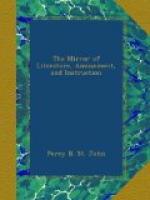The population of Oporto and Villa Nova was stated by Colonel Batty in 1830, to amount to about 80,000 inhabitants.
* * * * *
POETS, MINOR AND MAJOR.
Perhaps no branch of literary reputation is so difficult to establish as that of first-rate poetic excellence. During the last fifty years, many meritorious competitors for bardic renown have successively aspired to public favour, and have each in their turns exhibited their fancy-woven bouquets, as containing a more beautiful assemblage of “flowers of all hue,” as Milton divinely sings, than those which their equally emulative and praiseworthy compeers have, in their best attempts, laid out upon the parterre of the public. In the poetic foreground of the above period, are to be seen the names of Pye, Ogilvie, Whitehead, Tasker, Mason, Cowper, Merry, Jerningham, Woty, Hurdis, Pratt, Fitzgerald, &c. over whose metrical effusions, with the exception of the fifth and sixth, the clouds of obscurity have long since cast a darkening hue. Even the “Elegaic Sonnets” of Charlotte Smith, which first appeared in 1784, and formed a sort of poetical era in point of popularity, have long since “fallen into the sere and yellow leaf,” as it was discriminately hinted by Burns would be the case with his soul-breathing Letters; the Sonnets by the Rev. W.L. Bowles, although emanating from a beautiful fountain-spring of thought and feeling, which should have screened their writer from the venomous shaft of Byron, have already sunk beneath the meridian of their popularity; and the loaded ornamental rhymes of Darwin; the prettily embroidered couplets of Miss Seward, together with the Della Cruscan Rhymes of Mary Robinson, Mrs. Cowley, &c. are left like daisies, plucked from the greensward, to perish beneath unfeeling neglect. Who now reads the verses of Ann Yearsley, the poetic milkwoman, who was so lauded beyond her deserts, by Mrs. H. More?—few or none. Why is this revolution in public taste? Because those master-spirits which guide the present age, have




